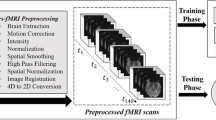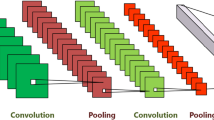Abstract
Purpose
Alzheimer's is the most common irreversible neurodegenerative disease. Its symptoms range from memory impairments to degradation of multiple cognitive abilities and ultimately death. Mild cognitive impairment (MCI) is the earliest detectable stage that happens between normal aging and early dementia, and even though MCI subjects have a chance of changing back to cognitively normal or even staying the same, there is a risk that their condition progresses to Alzheimer's disease (AD) annually. Therefore predicting AD among MCI subjects is pivotal for starting treatments at an opportune time in case of progression, and if staying stable is the case, the need for consistent medical observations would eliminate. Thus, we aim to diagnose possible conversion from MCI to AD by exploiting a class of deep learning (DL) methods called convolutional neural network (CNN).
Methods
We proposed a three-dimensional CNN (3D-CNN) to combine and analyze resting-state functional magnetic resonance imaging (rs-fMRI), clinical assessment results, and demographic information to predict conversion from MCI to AD in an average 5-years interval. Initially, a 3D-CNN was developed based on fMRI single volumes of 266 samples from 81 subjects; then, we used neuron layers to combine clinical data with fMRI to improve the results.
Results
At first, the CNN model demonstrated an AUC of 87.67% and an accuracy of 85.7%, then after combining clinical and rs-fMRI features, we observed the following improved scores: an AUC of 91.72%, an accuracy of 87.6%, a sensitivity of 75.58% and a specificity of 92.57%.
Conclusion
Our developed algorithm managed to predict prognosis from MCI to AD with high levels of accuracy, proving the potential of DL approaches in solving the matter and the efficiency of integrating clinical information with imaging according to the proposed method.





Similar content being viewed by others
References
Yiannopoulou KG, Papageorgiou SG (2020) Current and future treatments in alzheimer disease: an update. J Cent Nerv Syst Dis 12:1–12. https://doi.org/10.1177/1179573520907397
Weller J and Budson A (2018) Current understanding of Alzheimer's disease diagnosis and treatment. F1000Res 7: 1–9. https://doi.org/10.1268/f1000research.14506.1.
Mantzavinos V, Alexiou A (2017) Biomarkers for Alzheimer’s disease diagnosis. Curr Alzheimer Res 14(11):1149–1154. https://doi.org/10.2174/1567205014666170203125942
Sanford AM (2017) Mild cognitive impairment. Clin Geriatr Med 33(3):325–337. https://doi.org/10.1016/j.cger.2017.02.005
Neugroschl J, Wang S (2011) Alzheimer’s disease: diagnosis and treatment across the spectrum of disease severity. Mt Sinai J Med 78(4):596–612. https://doi.org/10.1002/msj.20279
Li Q, He S, Chen Y, Feng F, Qu W, Sun H (2018) Donepezil-based multi-functional cholinesterase inhibitors for treatment of Alzheimer’s disease. Eur J Med Chem 158:463–477. https://doi.org/10.1016/j.ejmech.2018.09.031
Ray B, Maloney B, Sambamurti K, Karnati HK, Nelson PT, Greig NH, Lahiri DK (2020) Rivastigmine modifies the α-secretase pathway and potentially early Alzheimer’s disease. Transl Psychiatry 10(1):47. https://doi.org/10.1038/s41398-020-0709-x
Koola MM (2020) Galantamine-Memantine combination in the treatment of Alzheimer’s disease and beyond. Psychiatry Res 293:113409. https://doi.org/10.1016/j.psychres.2020.113409
Padda I S and Parmar M (2021) Aducanumab. StatPearls [Internet].
Engelborghs S, Niemantsverdriet E, Struyfs H, Blennow K, Brouns R, Comabella M, Dujmovic I, van der Flier W, Frölich L, Galimberti D (2017) Consensus guidelines for lumbar puncture in patients with neurological diseases. Alzheimer’s Dementia: Diagnosis, Assess Dis Monit 8:111–126. https://doi.org/10.1016/j.dadm.2017.04.007
Anoop A, Singh PK, Jacob RS, Maji SK (2010) CSF Biomarkers for Alzheimer’s disease diagnosis. Int J Alzheimer’s Dis 2010:1–12. https://doi.org/10.4061/2010/606802
Judenhofer M S and Cherry S R, Applications for preclinical PET/MRI, Seminars in nuclear medicine, Elsevier, 2013, 19–29
Varghese T, Sheelakumari R, James JS, Mathuranath P (2013) A review of neuroimaging biomarkers of Alzheimer’s disease. Neurol Asia 18(3):239–248. https://doi.org/10.1186/s13024-019-0325-5
Lindquist MA (2008) The statistical analysis of fMRI data. Stat Sci 23(4):439–464
Devanand DP, Liu X, Tabert MH, Pradhaban G, Cuasay K, Bell K, de Leon MJ, Doty RL, Stern Y, Pelton GH (2008) Combining early markers strongly predicts conversion from mild cognitive impairment to Alzheimer’s disease. Biol Psychiatry 64(10):871–879. https://doi.org/10.1016/j.biopsych.2008.06.020
Zhao A, Li Y, Yan Y, Qiu Y, Li B, Xu W, Wang Y, Liu J, Deng Y (2020) Increased prediction value of biomarker combinations for the conversion of mild cognitive impairment to Alzheimer’s dementia. Transl Neurodegener 9(1):1–10. https://doi.org/10.1186/s40035-020-00210-5
DeTure MA, Dickson DW (2019) The neuropathological diagnosis of Alzheimer’s disease. Mol Neurodegener 14(1):32–50. https://doi.org/10.1186/s13024-019-0333-5
Tible M, Sandelius Å, Höglund K, Brinkmalm A, Cognat E, Dumurgier J, Zetterberg H, Hugon J, Paquet C, Blennow K (2020) Dissection of synaptic pathways through the CSF biomarkers for predicting Alzheimer disease. Neurology 95(8):e953–e961. https://doi.org/10.1212/wnl.0000000000010131
Lin W, Gao Q, Yuan J, Chen Z, Feng C, Chen W, Du M, Tong T (2020) Predicting Alzheimer’s disease conversion from mild cognitive impairment using an extreme learning machine-based grading method with multimodal data. Front Aging Neurosci 12:77–86. https://doi.org/10.3389/fnagi.2020.00077
Hojjati SH, Ebrahimzadeh A, Khazaee A, Babajani-Feremi A (2017) Predicting conversion from MCI to AD using resting-state fMRI, graph theoretical approach and SVM. J Neurosci Methods 282:69–80. https://doi.org/10.1016/j.jneumeth.2017.03.006
Hojjati SH, Ebrahimzadeh A, Khazaee A, Babajani-Feremi A (2018) Predicting conversion from MCI to AD by integrating rs-fMRI and structural MRI. Comput Biol Med 102:30–39. https://doi.org/10.1016/j.compbiomed.2018.09.004
Grassi M, Perna G, Caldirola D, Schruers K, Duara R, Loewenstein DA (2018) A clinically-translatable machine learning algorithm for the prediction of Alzheimer’s disease conversion in individuals with mild and premild cognitive impairment. J Alzheimer’s Dis: JAD 61(4):1555–1573. https://doi.org/10.3233/jad-170547
Grassi M, Rouleaux N, Caldirola D, Loewenstein D, Schruers K, Perna G, Dumontier M (2019) A novel ensemble-based machine learning algorithm to predict the conversion from mild cognitive impairment to Alzheimer’s disease using socio-demographic characteristics, clinical information, and neuropsychological measures. Front Neurol. https://doi.org/10.3389/fneur.2019.00756
Zhuang F, Qi Z, Duan K, Xi D, Zhu Y, Zhu H, Xiong H, He Q (2020) A comprehensive survey on transfer learning. Proc IEEE 109(1):43–76. https://doi.org/10.1109/JPROC.2020.3004555
Nanni L, Interlenghi M, Brahnam S, Salvatore C, Papa S, Nemni R, Castiglioni I and T A s D N I (2020) Comparison of transfer learning and conventional machine learning applied to structural brain MRI for the early diagnosis and prognosis of Alzheimer's disease. Front Neurol. https://doi.org/10.3389/fneur.2020.576194.
Gao F, Yoon H, Xu Y, Goradia D, Luo J, Wu T and Su Y (2020) AD-NET: Age-adjust neural network for improved MCI to AD conversion prediction. NeuroImage: Clinical, 27: 102290. https://doi.org/10.1016/j.nicl.2020.102290.
Abrol A, Fu Z, Du Y and Calhoun V D, Multimodal data fusion of deep learning and dynamic functional connectivity features to predict alzheimer’s disease progression, 2019 41st Annual international conference of the IEEE engineering in medicine and biology society (EMBC), IEEE, 2019, 4409–4413. https://doi.org/10.1109/EMBC.2019.8856500.
Nanni L, Brahnam S, Salvatore C, Castiglioni I (2019) Texture descriptors and voxels for the early diagnosis of Alzheimer’s disease. Artif Intell Med 97:19–26. https://doi.org/10.1016/j.artmed.2019.05.003
Morales E B, Saavedra K C R, Ángeles L J and Bañuelos V M, Brain tortuosity as biomarker to classify mild cognitive impairment and control subjects, Latin American conference on biomedical engineering, Springer, 2019, 327–333
Dachena C, Casu S, Lodi M B, Fanti A and Mazzarella G, Application of MRI, fMRI and cognitive data for alzheimer’s disease detection, 2020 14th European conference on antennas and propagation (EuCAP), 2020, pp. 1–4.https://doi.org/10.23919/EuCAP48036.2020.9135817.
Schaffer C (1993) Selecting a classification method by cross-validation. Mach Learn 13(1):135–143
Lynch C, Walsh C, Blanco A, Moran M, Coen R, Walsh J, Lawlor B (2006) The clinical dementia rating sum of box score in mild dementia. Dement Geriatr Cogn Disord 21(1):40–43. https://doi.org/10.1159/000089218
Marshall GA, Zoller AS, Lorius N, Amariglio RE, Locascio JJ, Johnson KA, Sperling RA, Rentz DM (2015) Functional activities questionnaire items that best discriminate and predict progression from clinically normal to mild cognitive impairment. Curr Alzheimer Res 12(5):493–502. https://doi.org/10.2174/156720501205150526115003
Su Y, Dong J, Sun J, Zhang Y, Ma S, Li M, Zhang A, Cheng B, Cai S, Bao Q, Wang S, Zhu P (2021) Cognitive function assessed by Mini-mental state examination and risk of all-cause mortality: a community-based prospective cohort study. BMC Geriatr 21(1):524. https://doi.org/10.1186/s12877-021-02471-9
Kueper JK, Speechley M, Montero-Odasso M (2018) The alzheimer’s disease assessment scale-cognitive subscale (ADAS-Cog): modifications and responsiveness in pre-dementia populations. A narrative review. J Alzheimer’s Dis : JAD 63(2):423–444. https://doi.org/10.3233/jad-170991
Khosravi Fard E, J L K, Akbarzadeh Bagheban A and R W K (2016) Comparison of the rey auditory verbal learning test (RAVLT) and digit test among typically achieving and gifted students. Iranian J Child Neurol 10 (2): 26-37
Chlebowski C (2011) Wechsler memory scale all versions. In: Kreutzer JS et al (eds) Encyclopedia of clinical neuropsychology. Springer, New York, pp 2688–2690
Salthouse TA (2011) What cognitive abilities are involved in trail-making performance? Intelligence 39(4):222–232. https://doi.org/10.1016/j.intell.2011.03.001
Zhang X, Yao L, Wang X, Monaghan J and McAlpine D. (2019) A survey on deep learning based brain computer interface: recent advances and new frontiers.
Yamashita R, Nishio M, Do RKG, Togashi K (2018) Convolutional neural networks: an overview and application in radiology. Insights Imaging 9(4):611–629. https://doi.org/10.1007/s13244-018-0639-9
Rawat W, Wang Z (2017) Deep convolutional neural networks for image classification: a comprehensive review. Neural Comput 29(9):2352–2449. https://doi.org/10.1162/NECO_a_00990
Bradley AP (1997) The use of the area under the ROC curve in the evaluation of machine learning algorithms. Pattern Recogn 30(7):1145–1159. https://doi.org/10.1016/S0031-3203(96)00142-2
Acknowledgements
The present article is financially supported by "Research Department of School of Medicine Shahid Beheshti University of Medical Sciences" (Grant No 29580).
Author information
Authors and Affiliations
Corresponding author
Ethics declarations
Conflict of interest
The authors declare that they have no conflict of interest.
Ethical approval
ADNI study is conducted according to Good Clinical Practice guidelines, US 21CFR Part 50– Protection of Human Subjects, and Part 56–Institutional Review Boards (IRBs)/Research Ethics Boards (REBs), and pursuant to state and federal HIPAA regulations.
Informed consent
Phone consents were obtained for all pre-screening procedures and written informed consent for the study were obtained from all participants and/or authorized representatives and the study partners before in person assessments were carried out.
Additional information
Publisher's Note
Springer Nature remains neutral with regard to jurisdictional claims in published maps and institutional affiliations.
Rights and permissions
About this article
Cite this article
Ghafoori, S., Shalbaf, A. Predicting conversion from MCI to AD by integration of rs-fMRI and clinical information using 3D-convolutional neural network. Int J CARS 17, 1245–1255 (2022). https://doi.org/10.1007/s11548-022-02620-4
Received:
Accepted:
Published:
Issue Date:
DOI: https://doi.org/10.1007/s11548-022-02620-4




